Análisis Espacial con Python

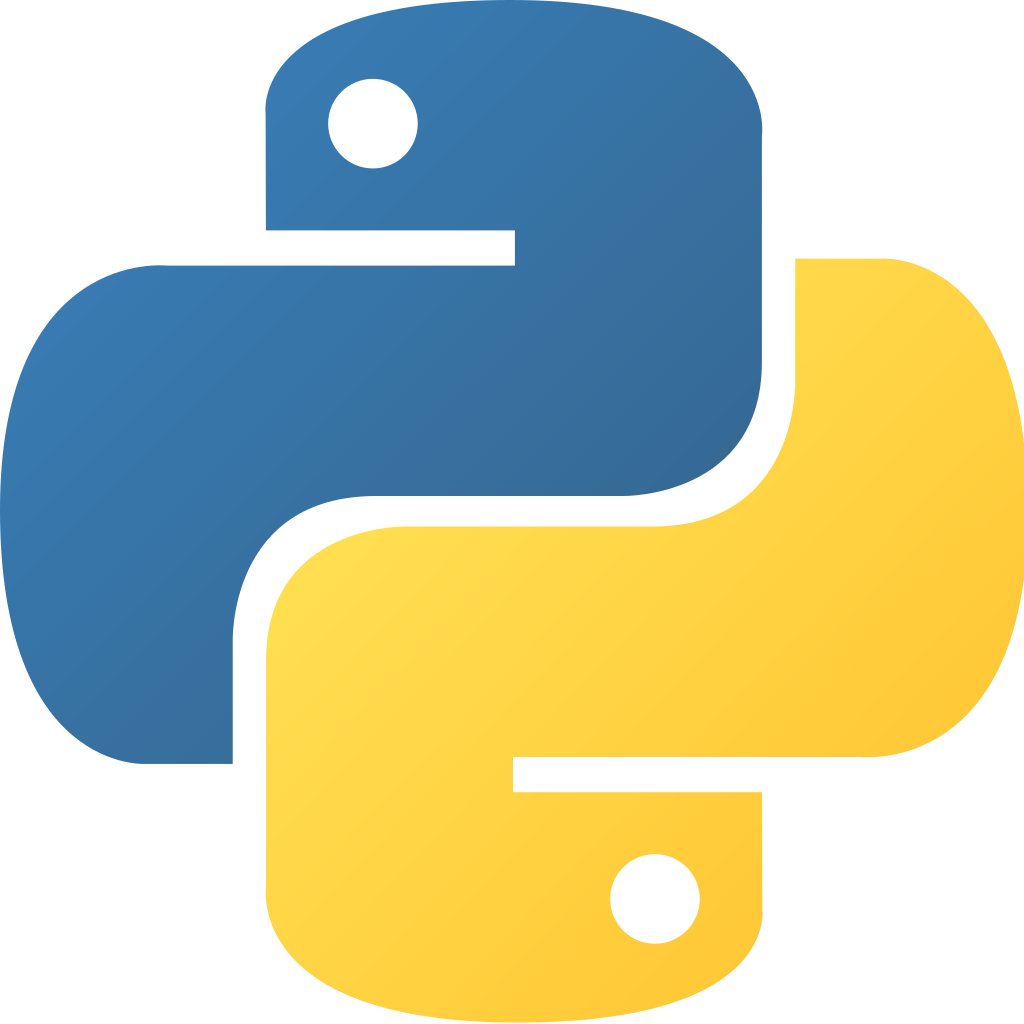
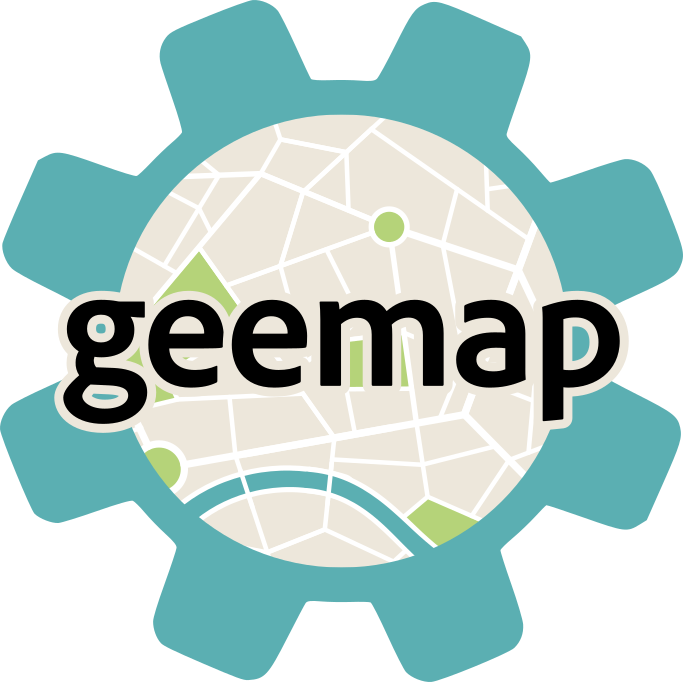

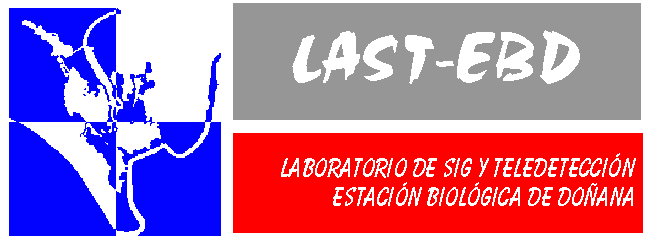

Curso Análisis Espacial con Python. Gabinete de Formación del CSIC.
Lugar: Sevilla, 23-27 de septiembre de 2024.
Profesor: Diego García Díaz.
Día 1
- Presentación del curso
- Presentación del profesor
- Presentación de los alumnos
- Introducción al entorno Jupyter
- Introducción a Python
- Tipos de datos
- Funciones
- Clases


Curso Análisis Espacial con Python. Gabinete de Formación del CSIC.
Lugar: Sevilla, 23-27 de septiembre de 2024.
Profesor: Diego García Díaz.
Día 1. Presentación del curso
Con suerte, aprenderemos un poco de todo

- Curso Introductorio sobre GeoPython
- Curso de Python
- Curso de SIG
- Curso de Teledetección


Curso Análisis Espacial con Python. Gabinete de Formación del CSIC.
Lugar: Sevilla, 23-27 de septiembre de 2024.
Profesor: Diego García Díaz.
Día 1. Presentación del curso
Introducción Curso y entorno Jupyter
Intro to Python
Teledetección &
Rasters
Teledetección
&
Rasters
Teledetección
& Rasters
Análisis Vectorial
Análisis Vectorial
Análisis Vectorial
¿Geemap?
¿Geemap?


Curso Análisis Espacial con Python. Gabinete de Formación del CSIC.
Lugar: Sevilla, 23-27 de septiembre de 2024.
Profesor: Diego García Díaz.


Curso Análisis Espacial con Python. Gabinete de Formación del CSIC.
Lugar: Sevilla, 23-27 de septiembre de 2024.
Profesor: Diego García Díaz.

- Acceso a Servicios Web Mapping
- Asistencia científica en SIG y Teledetección
- Asistencia equipamiento tecnológico (GPS, radiometría, drones, impresión 3D...)
- Cursos y formación
- Proyectos científicos propios
- Programa de Seguimiento Doñana



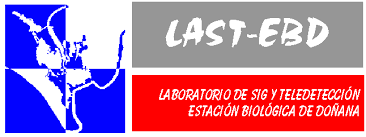
Día 1. Presentación del curso

Javier Bustamante Díaz
Responsable científico
(Investigador Científico)
Ricardo Díaz-Delgado Hernández
Dr. Biología
Isabel Afán Asencio
Dra. Biología
David Aragonés Borrego
Responsable Técnico. Ingeniero Forestal
Diego García Díaz
Geógrafo
Pedro Gómez Giráldez
Dr. Ingeniería de Montes
Gabriela P. Romero Olivos
Geógrafa
Día 1. Presentación del profesor


Curso Análisis Espacial con Python. Gabinete de Formación del CSIC.
Lugar: Sevilla, 23-27 de septiembre de 2024.
Profesor: Diego García Díaz.
Día 1. Presentación de los alumnos
Estación Biológica de Doñana
Otros centros CSIC
- Valle Egea Cobrero
- Daniel García García
- Andrea García Regalado
- Julia Jaca Estepa
- Lucía Jiménez Ríos
- Christina Andres Rueda Ayala
- Ricardo Felix Sánchez Leal
- Miguel Sevilla Callejo
- Pablo Yeste Lizan



Curso Análisis Espacial con Python. Gabinete de Formación del CSIC.
Lugar: Sevilla, 23-27 de septiembre de 2024.
Profesor: Diego García Díaz.
Día 1. ¿Por qué Geo Python?
Python & GIS



Curso Análisis Espacial con Python. Gabinete de Formación del CSIC.
Lugar: Sevilla, 23-27 de septiembre de 2024.
Profesor: Diego García Díaz.
Día 1. ¿Por qué Geo Python?
Un lenguaje interpretado
Python es un lenguaje interpretado, lo que significa que ejecuta directamente el código línea por línea. Si existen errores en el código del programa, su ejecución se detiene. Así, los programadores pueden encontrar errores en el código con rapidez.
Un lenguaje fácil de utilizar
Python utiliza palabras similares a las del inglés. A diferencia de otros lenguajes de programación, Python no utiliza llaves. En su lugar, utiliza sangría.
Un lenguaje tipeado dinámicamente
Los programadores no tienen que anunciar tipos de variables cuando escriben código porque Python los determina en el tiempo de ejecución. Debido a esto, es posible escribir programas de Python con mayor rapidez.
Un lenguaje de alto nivel
Python es más cercano a los idiomas humanos que otros lenguajes de programación. Por lo tanto, los programadores no deben preocuparse sobre sus funcionalidades subyacentes, como la arquitectura y la administración de la memoria.
Un lenguaje orientado a los objetos
Python considera todo como un objeto, pero también admite otros tipos de programación, como la programación estructurada y la funcional.
https://aws.amazon.com/es/what-is/python/Guido V. Rossum. 0.9.0v 1.0 v 2.0 v 3.0 1991199420002008v 3.12.6 v 3.0 

Curso Análisis Espacial con Python. Gabinete de Formación del CSIC.
Lugar: Sevilla, 23-27 de septiembre de 2024.
Profesor: Diego García Díaz.
Día 1. ¿Por qué Geo Python?


Curso Análisis Espacial con Python. Gabinete de Formación del CSIC.
Lugar: Sevilla, 23-27 de septiembre de 2024.
Profesor: Diego García Díaz.
Día 1. ¿Por qué Geo Python?


Curso Análisis Espacial con Python. Gabinete de Formación del CSIC.
Lugar: Sevilla, 23-27 de septiembre de 2024.
Profesor: Diego García Díaz.
Día 1. ¿Por qué Geo Python?
- Lenguaje en continuo crecimiento
- Muy usado en IA, Big Data, Web Mapping
- Principales softwares GIS utilizan python como lenguaje de scripting (ArcPy, PyQGIS)
- Complementa muy bien con otros lenguajes
- Integración con Bases de Datos
- Multitud de librerías para trabajar con datos espaciales (PyProj, Shapely, Geopandas, Fiona, Rasterio, etc...)
https://geoawesomeness.com/python-future-web-gis/

Curso Análisis Espacial con Python. Gabinete de Formación del CSIC.
Lugar: Sevilla, 23-27 de septiembre de 2024.
Profesor: Diego García Díaz.
Día 1. ¿Por qué Geo Python?


Curso Análisis Espacial con Python. Gabinete de Formación del CSIC.
Lugar: Sevilla, 23-27 de septiembre de 2024.
Profesor: Diego García Díaz.
Día 1. Introducción al Entorno Jupyter
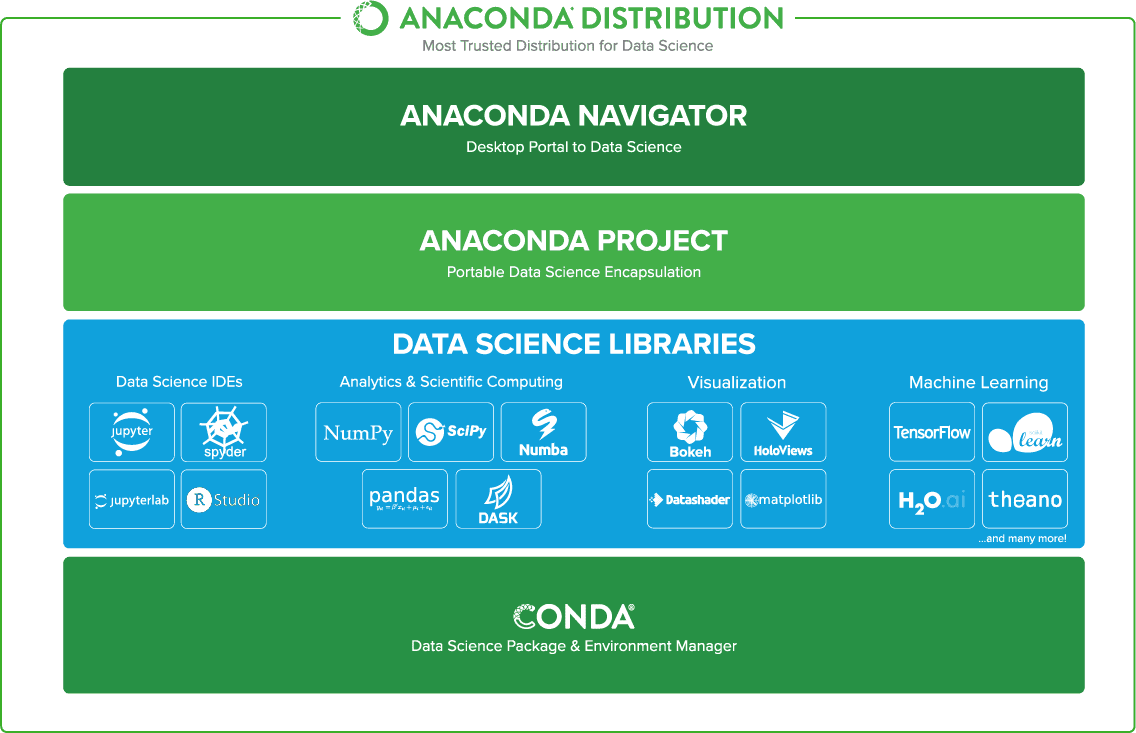


Curso Análisis Espacial con Python. Gabinete de Formación del CSIC.
Lugar: Sevilla, 23-27 de septiembre de 2024.
Profesor: Diego García Díaz.
Día 1. Introducción al Entorno Jupyter



Curso Análisis Espacial con Python. Gabinete de Formación del CSIC.
Lugar: Sevilla, 23-27 de septiembre de 2024.
Profesor: Diego García Díaz.


Curso Análisis Espacial con Python. Gabinete de Formación del CSIC.
Lugar: Sevilla, 12-16 de junio de 2023.
Profesor: Diego García Díaz.
Día 1. Introducción al Entorno Jupyter

Día 2
-
Clases en Python
-
Intro Teledetección
-
Shapely
-
Geopandas (aspect=1)


Curso Análisis Espacial con Python. Gabinete de Formación del CSIC.
Lugar: Sevilla, 23-27 de septiembre de 2024.
Profesor: Diego García Díaz.
Día 2. Breve Introducción a la Teledetección

- Hay casi 6.000 satélites orbitando alrededor de la tierra.
- Un 60% inactivos y convertidos en basura espacial
- ~ 2400 satélites activos
- Distintos tipos de sensores
- Distintos tipos de niveles de procesado




Curso Análisis Espacial con Python. Gabinete de Formación del CSIC.
Lugar: Sevilla, 23-27 de septiembre de 2024.
Profesor: Diego García Díaz.
Día 2. Breve Introducción a la Teledetección
Espectral
Espacial
Temporal

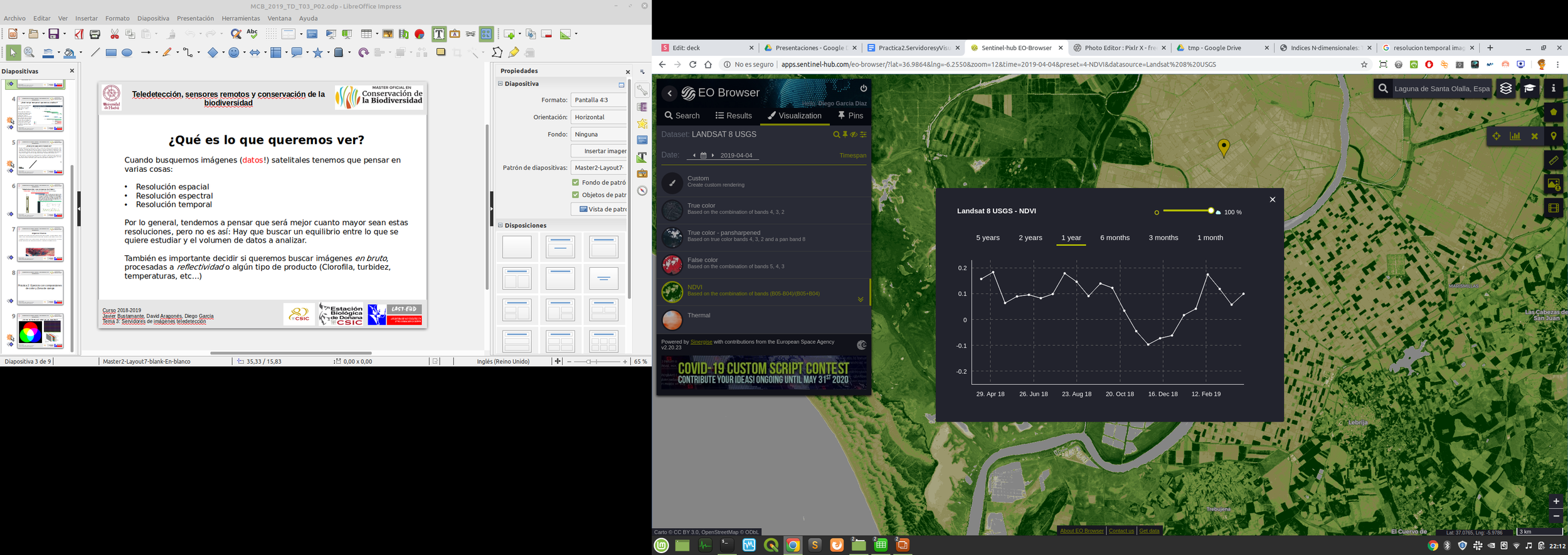




Curso Análisis Espacial con Python. Gabinete de Formación del CSIC.
Lugar: Sevilla, 23-27 de septiembre de 2024.
Profesor: Diego García Díaz.




Día 2. Breve Introducción a la Teledetección
Satellite image = Data!
| 2 | 5 | 8 | 6 | 7 |
|---|---|---|---|---|
| 8 | 7 | 5 | 6 | 3 |
| 0 | 0 | 0 | 0 | 1 |
| 2 | 2 | 3 | 0 | 0 |
| 4 | 4 | 8 | 2 | 5 |
1. Earth Explorer (USGS)
https://earthexplorer.usgs.gov/
2.. SciHub (ESA)
https://scihub.copernicus.eu/
3. EO Browser (ESA)
http://apps.sentinel-hub.com/eo-browser/
4. Land Viewer (EOS)
https://lv.eosda.com/
| 2 | 5 | 8 | 6 | 0 |
|---|---|---|---|---|
| 8 | 7 | 5 | 6 | 3 |
| 0 | 0 | 0 | 0 | 1 |
| 2 | 2 | 3 | 0 | 0 |
| 3 | 4 | 8 | 2 | 5 |


| 0.2 | 0.5 | -0.1 | 0.2 | 0.3 |
|---|---|---|---|---|
| -0.3 | -0.1 | 0 | 0.2 | 0.4 |
| 0 | 0 | 0 | 0 | 1 |
| 0.2 | 0.3 | 0.4 | 0.1 | 0 |
| -0.2 | -0.5 | -0.4 | 0.1 | 0.3 |

Images download



Curso Análisis Espacial con Python. Gabinete de Formación del CSIC.
Lugar: Sevilla, 23-27 de septiembre de 2024.
Profesor: Diego García Díaz.
Día 2. Landsat & Protocolo




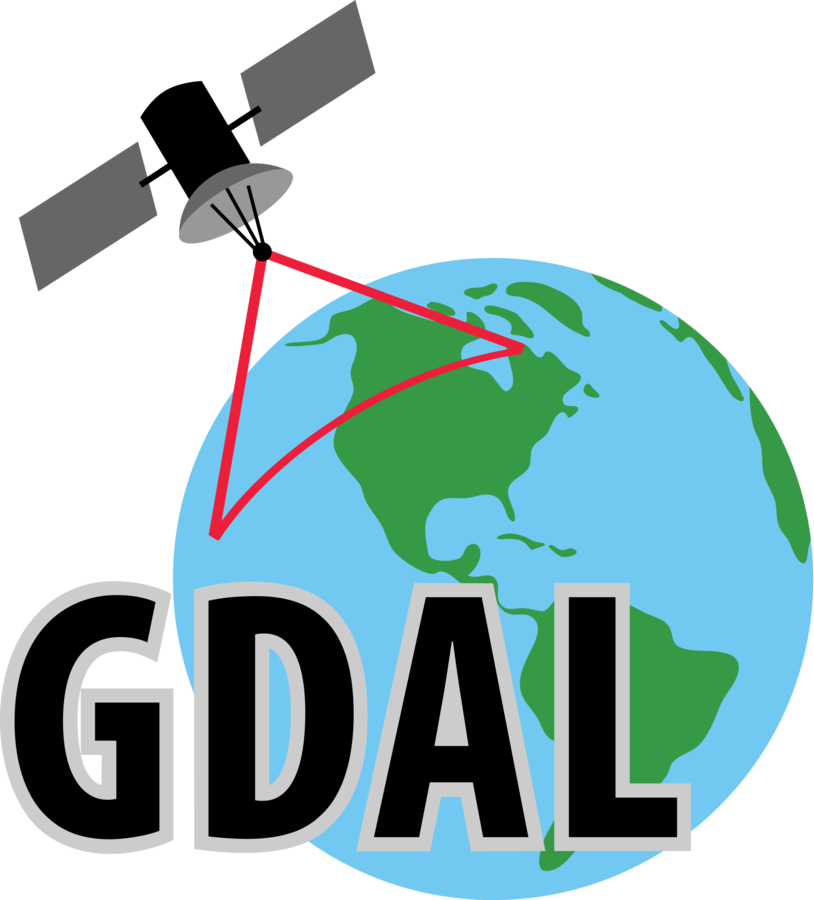


Curso Análisis Espacial con Python. Gabinete de Formación del CSIC.
Lugar: Sevilla, 23-27 de septiembre de 2024.
Profesor: Diego García Díaz.

Día 2. Landsat & Protocolo


Curso Análisis Espacial con Python. Gabinete de Formación del CSIC.
Lugar: Sevilla, 23-27 de septiembre de 2024.
Profesor: Diego García Díaz.
Día 2. Landsat & Protocolo


Curso Análisis Espacial con Python. Gabinete de Formación del CSIC.
Lugar: Sevilla, 23-27 de septiembre de 2024.
Profesor: Diego García Díaz.

Día 2. Landsat & Protocolo


Curso Análisis Espacial con Python. Gabinete de Formación del CSIC.
Lugar: Sevilla, 23-27 de septiembre de 2024.
Profesor: Diego García Díaz.
Día 3
Análisis Vectorial
Intro Numpy
Intro Rasterio


Curso Análisis Espacial con Python. Gabinete de Formación del CSIC.
Lugar: Sevilla, 23-27 de septiembre de 2024.
Profesor: Diego García Díaz.
- Move Points inside polygons
- Max Lenght inside polygons
Día 3
Principales librerías de Python para trabajar con datos Geográficos
-
GDAL –> Fundamental package for processing raster data formats (many modules below depend on this)
-
Geopandas –> Working with geospatial data in Python made easier, combines the capabilities of pandas and shapely.
-
Shapely –> Python package for manipulation and analysis of planar geometric objects (based on widely deployed GEOS).
-
Fiona –> Reading and writing spatial data (alternative for geopandas).
-
Pyproj –> Performs cartographic transformations and geodetic computations (based on PROJ.4).
-
Pysal –> Library of spatial analysis functions written in Python.
-
Geopy –> Geocoding library: coordinates to address <-> address to coordinates.
-
Contextily –> Add background basemaps for your (static) map visualizations
-
Streamlit->Streamlit turns data scripts into shareable web apps in minutes. All in pure Python. No front‑end experience required.
-
GeoViews –> Interactive Maps for the web.
-
OSMnx –> Python for street networks. Retrieve, construct, analyze, and visualize street networks from OpenStreetMap
-
Networkx –> Network analysis and routing in Python (e.g. Dijkstra and A* -algorithms), see this post.
-
Cartopy –> Make drawing maps for data analysis and visualisation as easy as possible.
-
Scipy.spatial –> Spatial algorithms and data structures.
-
Rasterio –> Clean and fast and geospatial raster I/O for Python.
-
RSGISLib –> Remote Sensing and GIS Software Library for Python.
-
Geemap -> Python API for Google Earth Engine. The power of GEE and Python combine with ipyleaflet maps
Fuente: Modificado de Automating GIS Processing Course. https://autogis-site.readthedocs.io/

Curso Análisis Espacial con Python. Gabinete de Formación del CSIC.
Lugar: Sevilla, 23-27 de septiembre de 2024.
Profesor: Diego García Díaz.
Día 3


Curso Análisis Espacial con Python. Gabinete de Formación del CSIC.
Lugar: Sevilla, 23-27 de septiembre de 2024.
Profesor: Diego García Díaz.
Inciso Environments
- conda create -n aep2024 python=3.9 pandas=1.1 geemap=0.9
Crear un environment definiendo la versión de python y las librerías a usar (también sus versiones)
- conda create --name aep2024 --file requirements.txt
Crear un environment en base a los requirements definidos en un archivo
creación del archivo requirements: conda list --explicit -> requirements.txt
- conda create --name aep2024 --file env.yml
Crear un environment en base a los requirements definidos en un archivo
creación del archivo yml: conda env export > environment.yml
Día 3


Curso Análisis Espacial con Python. Gabinete de Formación del CSIC.
Lugar: Sevilla, 23-27 de septiembre de 2024.
Profesor: Diego García Díaz.
Inciso Environments
Día 3


Curso Análisis Espacial con Python. Gabinete de Formación del CSIC.
Lugar: Sevilla, 23-27 de septiembre de 2024.
Profesor: Diego García Díaz.
Inciso Environments
¡pixi install gdal!
-
curl -LsSf https://astral.sh/uv/install.sh | sh (instalamos el paquete UV de astral)
-
mkdir "~/geo" (creaamos el directorio para el env)
-
uv venv (creamos entorno virtual)
-
source .venv/bin/activate (activamos el env)
-
uv pip install geospatial (instalamos geospatial)
-
uv pip install --find-links https://girder.github.io/large_image_wheels gdal pyproj (solucionariamos gdal)
-
deactivate
Día 3
En principio terminaremos de ver el notebook del otro día (aspect=1) y veremos como trabajar con shapefiles desde fiona (que nos servirá para entender mejor rasterio), y trataremos de analizar/entender los scripts para calcular las líneas máximas contenidas dentro de polígonos y desplazar y rotar puntos de forma aleatoria dentro de un polígono.


Curso Análisis Espacial con Python. Gabinete de Formación del CSIC.
Lugar: Sevilla, 23-27 de septiembre de 2024.
Profesor: Diego García Díaz.
Día 3


Curso Análisis Espacial con Python. Gabinete de Formación del CSIC.
Lugar: Sevilla, 23-27 de septiembre de 2024.
Profesor: Diego García Díaz.

Día 3


Curso Análisis Espacial con Python. Gabinete de Formación del CSIC.
Lugar: Sevilla, 23-27 de septiembre de 2024.
Profesor: Diego García Díaz.
https://drive.google.com/drive/folders/14Bap4Q4Qc_oTl-ye5I5AG5Xhq47kkCI9?usp=sharing
Raster Data
Día 4
Análisis raster
Intro Numpy
Intro Rasterio
Clase Landsat


Curso Análisis Espacial con Python. Gabinete de Formación del CSIC.
Lugar: Sevilla, 23-27 de septiembre de 2024.
Profesor: Diego García Díaz.
Día 5
Repaso Rasterio/Fiona
- Sample Points Fincas Doñana
- Joins (attributes & Spatial)
- Polygonize
Clase Landsat?
Geemap


Curso Análisis Espacial con Python. Gabinete de Formación del CSIC.
Lugar: Sevilla, 23-27 de septiembre de 2024.
Profesor: Diego García Díaz.
Día 5
Inciso!


Curso Análisis Espacial con Python. Gabinete de Formación del CSIC.
Lugar: Sevilla, 23-27 de septiembre de 2024.
Profesor: Diego García Díaz.
OSMNX
Día 5


Curso Análisis Espacial con Python. Gabinete de Formación del CSIC.
Lugar: Sevilla, 23-27 de septiembre de 2024.
Profesor: Diego García Díaz.
Geopandas tiene una documentación muy buena
Día 5
Google Earth Engine


- Cambio de paradigma
- Plataforma en la nube para la visualización y el procesado de información cartográfica
- Petabytes de datos (imágenes satélite de diversos satélites/sensores)
- Datos rasters (Coberturas de usos del suelo, datos climáticos, etc...)
- Datos vectoriales
- Posibilidad de usar datasets propios
- Algoritmos de computación (posibilidad de desarrollar nuevos)
- Aplicaciones a escala global
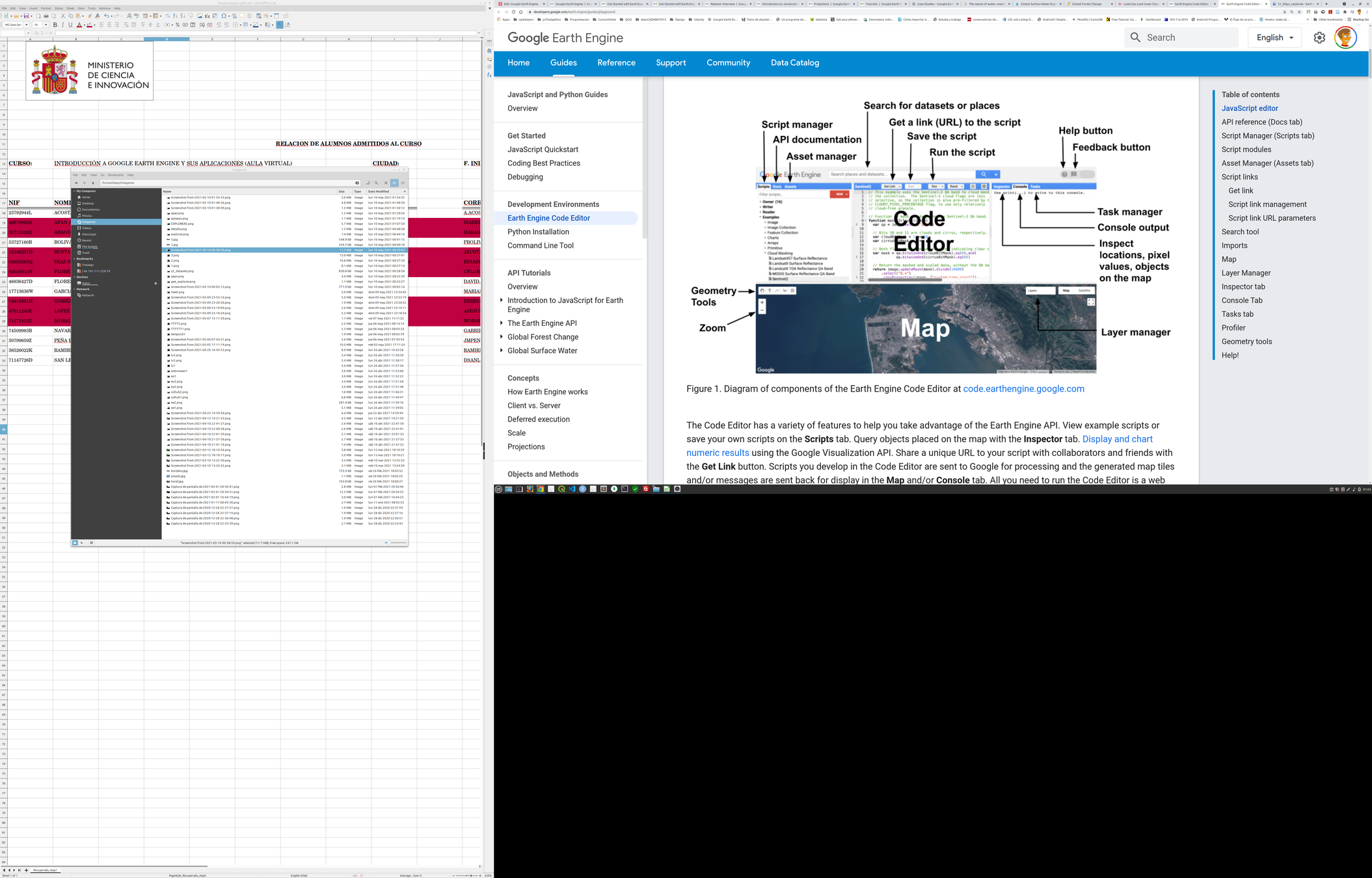



Curso Análisis Espacial con Python. Gabinete de Formación del CSIC.
Lugar: Sevilla, 23-27 de septiembre de 2024.
Profesor: Diego García Díaz.
Día 5


Curso Análisis Espacial con Python. Gabinete de Formación del CSIC.
Lugar: Sevilla, 23-27 de septiembre de 2024.
Profesor: Diego García Díaz.
Geemap
Python package based in Google Earth Engine python API and Map application Leaflet


https://www.youtube.com/c/Qiushengwu
Día 5


Curso Análisis Espacial con Python. Gabinete de Formación del CSIC.
Lugar: Sevilla, 23-27 de septiembre de 2024.
Profesor: Diego García Díaz.
Ndvi2Gif
Python packaged built upon Geemap to work with seasonal vegetation indexes by getting pixel statistics for periods of time






-
https://freelearning.anaconda.cloud/get-started-with-anaconda - https://geo-python-site.readthedocs.io/en/latest/
- https://geopandas.org/en/stable/docs/user_guide/io.html
- https://shapely.readthedocs.io/en/stable/manual.html
- https://www.earthdatascience.org/workshops/gis-open-source-python/
- https://earthpy.readthedocs.io/en/latest/
- https://autogis-site.readthedocs.io/en/latest/index.html
- https://geemap.org/
- https://www.youtube.com/@giswqs
- https://eo-college.org/courses/
Recursos




Curso Análisis Espacial con Python. Gabinete de Formación del CSIC.
Lugar: Sevilla, 23-27 de septiembre de 2024.
Profesor: Diego García Díaz.
Zacabó!!!!!


Curso Análisis Espacial con Python. Gabinete de Formación del CSIC.
Lugar: Sevilla, 23-27 de septiembre de 2024.
Profesor: Diego García Díaz.


